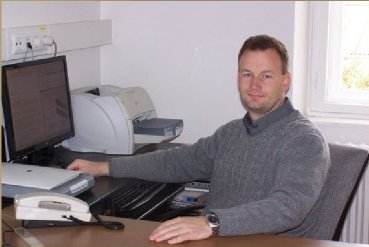 Zoltán ERDÉLYI is the head of the Department of Solid State Physics at the University of Debrecen (Hungary).
Zoltán ERDÉLYI is the head of the Department of Solid State Physics at the University of Debrecen (Hungary).
He graduated at the University of Lajos Kossuth (Debrecen, Hungary) in 1998. In 2001, he received his PhD in Materials Science from the University of Aix-Merseille III. In 2002, he received his second PhD degree in Physics specialized to Solid State Physics from the University of Debrecen. In 2010, he obtained his Habilitation in Physics from the University of Debrecen (Hungary). He is the (co-)author of more than 100 scientific publications including book chapters and high ranked journals, such as SCIENCE, Phys. Rev. Lett., Acta Mat., Appl. Phys. Lett., Phys. Rev. B (Curriculum Vitae)
His research field has been focusing mainly on interface related phenomena in nano-materials, such as multilayers and thin films. His work includes theoretical, computer simulation and experimental activities. At the beginning of his carrier he worked on diffusion and surface segregation. Then he gradually turned towards reactive-diffusion, i.e. solid state reaction. Now, he still works on reactive-diffusion in materials of high industrial potential and not only in planar but curved (spherical and cylindrical) geometries. Meantime, an Atomic Layer Deposition (ALD) reactor has been installed in his laboratory and on the basis of this technique he is building up a new field which is expected to be even closer to applications.
personal website: web.unideb.hu/zerdelyi
Mykola PASICHNYY is an Associate Professor at Physics Department of Bohdan Khmelnytskyy National University at Cherkasy. 2001 – graduated from Cherkasy State University with the degree in physics. 2002-2005 – PhD student at the Bohdan Khmelnytskyy National University at Cherkasy, supervisor Prof. Andriy Gusak.
2006 – defense of PhD thesis in solid-state physics at the G. V. Kurdyumov Institute for Metal Physics of the Ukrainian Academy of Sciences in Kiev. The thesis was directed to the modeling of the initial stages of solid-state reactions.
His research field is focusing in the theory and modeling of new phase nucleation, growth and competition during reactive diffusion or decomposition, diffusion and diffusional phase transformations.
 Volodymyr BEZPALCHUK is a PhD student at the B. Khmelnitsky Cherkasy National University (Cherkasy, Ukraine). His supervisors are Prof. Andriy Gusak and PhD Alexander Bogatyrev. He is a teaching Assistant of Applied Mathematics. He graduated in 2011 from Bogdan Khmelnitsky Cherkasy National University with a master degree in Applied mathematics.
Volodymyr BEZPALCHUK is a PhD student at the B. Khmelnitsky Cherkasy National University (Cherkasy, Ukraine). His supervisors are Prof. Andriy Gusak and PhD Alexander Bogatyrev. He is a teaching Assistant of Applied Mathematics. He graduated in 2011 from Bogdan Khmelnitsky Cherkasy National University with a master degree in Applied mathematics.
János J. TOMÁN is a PhD Student of the Department of Solid State Physics at University of Debrecen (Hungary). He has been working under the supervision of Zoltán Erdélyi since 2012. He received his Master (MSc) degree in 2013 at University of Debrecen as a materials scientist focused on nanomaterials. Since the same year he is a PhD student in Debrecen.
His research field is focusing on the simulation of diffusion and solid-state reactions on nano-scale. His work includes continuum modelling as well as (Stochastic) Kinetic Mean Field simulations. During his master studies he spent 14 month at Imec (Leuven, Belgium) working on the field of back-wall passivation of solar cells with Atomic Layer Deposited (ALD) aluminium-oxide.

Bence GAJDICS is a master student at Materials science. He is about to finish his studies at the University of Debrecen (Debrecen, Hungary).
The development of the SKMF model was a part of his diploma work. He is expected to graduate in June, 2016. His diploma work supervisors are Zoltán ERDÉLYI and János J. TOMÁN.
 Andriy GUSAK – Professor and Chair, Department of Physics at Cherkasy National University, Ukraine. Graduated from Moscow State University in 1976 with honours, specialized in theoretical physics. 1978-1982 – PhD student an the Institute of Metallurgy of Academy of Sciences of USSR (Moscow), supervisor prof.Cyrill Gurov. In 1983 – defended a PhD thesis in the Institute for Metal Physics, Ukrainian Academy of Sciences (Kiev). In 1992 defended second thesis and has got habilitation at Kharkov State (now National) University. Since 1994 – Full Professor. Since 1996 – Honoured worker of science and technology of Ukraine.
Andriy GUSAK – Professor and Chair, Department of Physics at Cherkasy National University, Ukraine. Graduated from Moscow State University in 1976 with honours, specialized in theoretical physics. 1978-1982 – PhD student an the Institute of Metallurgy of Academy of Sciences of USSR (Moscow), supervisor prof.Cyrill Gurov. In 1983 – defended a PhD thesis in the Institute for Metal Physics, Ukrainian Academy of Sciences (Kiev). In 1992 defended second thesis and has got habilitation at Kharkov State (now National) University. Since 1994 – Full Professor. Since 1996 – Honoured worker of science and technology of Ukraine.
He works mainly in the field of theory and modeling of interdiffusion, solid-state reactions and phase transformations in nanosystems. Most well-known results of Andriy Gusak: Theory of nucleation in sharp concentration gradient (simultaneously and then jointly with Pierre Desre, and later with Fiqiri Hodaj); Theory of Flux Driven Ripening in soldering reactions (jointly with King Ning Tu); Theory of hollow nanoshell formation and collapse (jointly with King Ning Tu, Ulrich Goesele, Tetyana Zaporozhets); Theory of inter- and reactive diffusion with limited power of vacancy sinks-sources; Concept of kinetically unstable Kirkendall planes (jointly with Frans van Loo, Mark van Dal, Alexander Kodentsov, Csaba Cserhati); Theory of phase competition at nucleation stage (flux driven nucleation suppression) (jointly with Cyrill Gurov, Guido Schmitz); Theory of nucleation in nanovolumes (jointly with Aram Shirinyan, Andriy Kovalchuk)
Profiles: Google Scholar, ResearchGate, ORCID, SCOPUS, Cherkasy National University